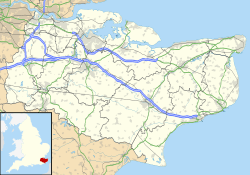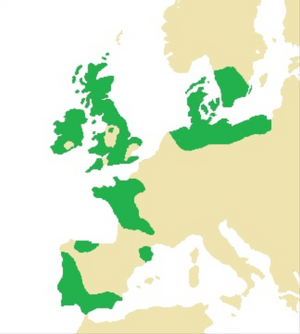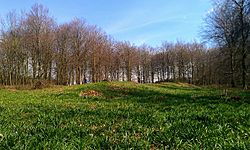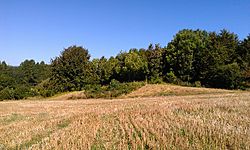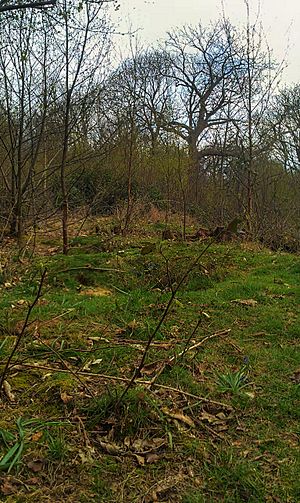Shrub's Wood Long Barrow facts for kids
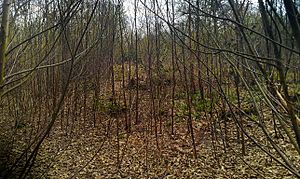
Shrub's Wood Long Barrow is found within woodland and has trees growing in it
|
|
| Location | Elmsted, Kent |
|---|---|
| Coordinates | 51°10′25″N 1°00′06″E / 51.17357°N 1.00178°E |
| Type | Long barrow |
| History | |
| Founded | Early Neolithic |
| Designated | 1969 |
| Reference no. | 1012523 |
Shrub's Wood Long Barrow is an ancient burial mound located near Elmsted village in Kent, England. It was likely built around 4,000 to 4,500 BCE. This was during Britain's Early Neolithic period. The barrow is made of earth and looks like a long, low hill. It has ditches on its sides.
Archaeologists believe early farmers and herders built this monument. They had recently brought farming to Britain from Europe. Shrub's Wood Long Barrow is part of a tradition of building long mounds across Europe. However, it's also a special type found only near the River Stour. It sits on the east side of the river. Other similar mounds nearby are Julliberrie's Grave and Jacket's Field Long Barrow. Shrub's Wood Long Barrow was found in the late 1960s. It has not yet been fully explored by archaeologists.
Contents
Where is Shrub's Wood Long Barrow?
Shrub's Wood Long Barrow is located in a wooded area called Shrub's Wood. This wood is close to the village of Elmsted. You can see the barrow from a public path nearby. The mound sits on sandy ground. The North Downs trackway is about 2 kilometers (1.2 miles) southwest of the barrow.
Understanding the Neolithic Period
The Early Neolithic was a time of big change in Britain. Between 4500 and 3800 BCE, people started farming. They stopped living as hunter-gatherers. This change happened because of contact with people from Europe. It's not clear if new people arrived or if Britons learned farming from others. Kent was an important area for these new ideas. This was because of its location near the River Thames and Europe.
Most of Britain was covered in forests back then. Large forests in Kent were not cleared until the Late Bronze Age (around 1000 to 700 BCE). During the Early Neolithic, people mostly raised cattle. They lived a nomadic or semi-nomadic life. This means they moved around with their animals. Even though people across Britain shared similar tools, their homes and ways of life varied.
Ancient Burial Mounds: Stour Long Barrows
In Western Europe, the Early Neolithic was when people first built huge structures. Many of these were tombs for the dead. Some were made of wood, and many used large stones called megaliths. People were usually buried together in these tombs. Building these tombs started in Europe. It then came to Britain in the early 3000s BCE. Many experts think these tombs show that people honored their ancestors. Historian Ronald Hutton called them "tomb-shrines." This shows they were used for both burials and ceremonies.
In Britain, long barrows were often built on hills. They overlooked the land around them. These tombs might have marked different tribal areas. Or they could have been markers along paths for herding animals. Building these monuments might have shown a new idea of owning land. Some think these sites were already sacred to earlier hunter-gatherers.
About twelve Neolithic long barrows are known in Kent. The most famous are the Medway Megaliths. These are near the River Medway and have stone burial chambers. Examples include the Coldrum Stones and Kit's Coty House.
About 38 kilometers (24 miles) east of the Medway Megaliths are the Stour Long Barrows. This group has three known mounds: Jacket's Field Long Barrow, Julliberrie's Grave, and Shrub's Wood Long Barrow. They are all within 8 kilometers (5 miles) of each other. They sit high up on the North Downs between Canterbury and Ashford. Jacket's Field is west of the River Stour. Shrub's Wood and Julliberrie's Grave are on the east side. Unlike the Medway Megaliths, the Stour Long Barrows do not use stone. This was likely a choice, as stones were available nearby.
The presence of these long barrows suggests people lived nearby in the Early Neolithic. Two polished flint axes from this time were found at Soakham Farm. This farm is not far from Jacket's Field Long Barrow. The North Downs trackway might have been used then. It would have helped people travel west. In other parts of southern Britain, long barrows were often built near large circular enclosures. However, none have been found near the Stour Long Barrows yet.
What Shrub's Wood Long Barrow Looks Like
Shrub's Wood Long Barrow is oval shaped. It is about 19 meters (62 feet) wide at its widest point. It runs from east to west and is 38 meters (125 feet) long. The eastern end of the barrow is 2 meters (6.5 feet) high. The western end is a little shorter. There are ditches on both sides of the mound. These ditches are slightly curved. They measure between 5 and 7 meters (16 to 23 feet) wide. Experts say it is "amongst the finest surviving oval barrows in the South-East."
How Shrub's Wood Long Barrow Was Found
Julliberrie's Grave has been known for centuries. But Shrub's Wood Long Barrow, and Jacket's Field Long Barrow, were found much later. Archaeologist Ronald Jessup explored Julliberrie's Grave in the 1930s. He thought more long barrows would be found in the area. In 1970, J. Bradshaw reported that Shrub's Wood Long Barrow had been "recently recorded." When it was found, it became a Scheduled Ancient Monument. This protects it from harm. As of 2007, neither Shrub's Wood Long Barrow nor Jacket's Field Long Barrow had been fully dug up by archaeologists.


